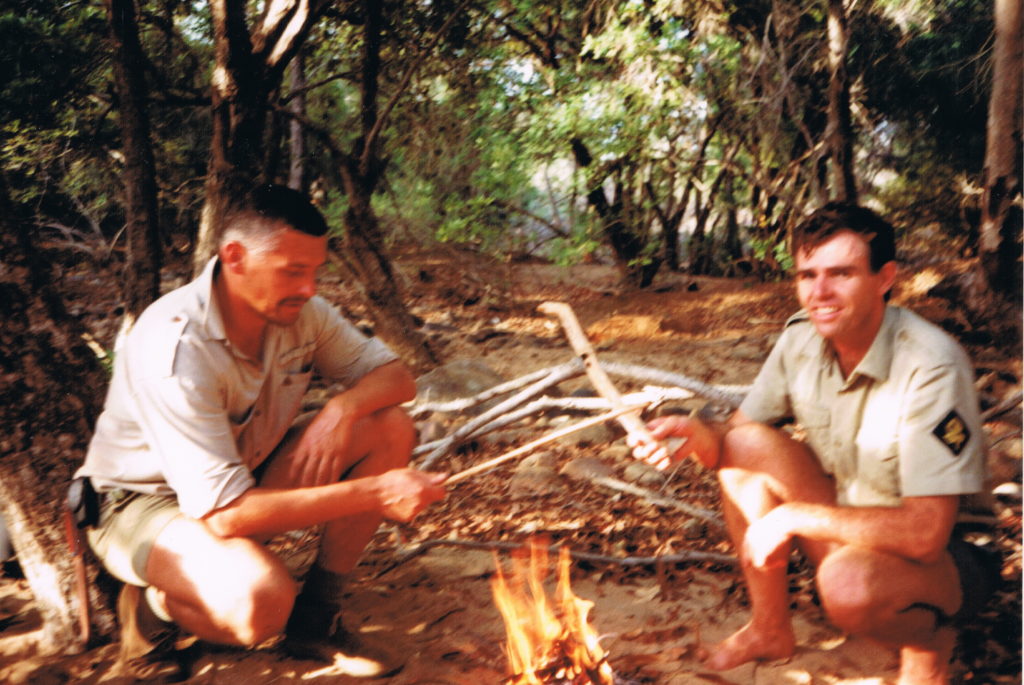The type of wood for fire hand drills changed over time
Fire starting with friction hand drills was traditionally common among Khoi-san (Ju//hoansi) people in their distribution area, which was once over Southern Africa and became increasingly confined by invading Bantu tribes and White colonists. Now, they are restricted to some areas within and around the Kalahari.

With this restriction in space, there was also a restriction in available materials for tools, implements, building materials, pots, etc. For lighting fires, it was necessary to change from one type of wood fire set to two kinds over time.
Type of wood for fire hand drills in the Lowveld area
When Khoi-san still settled in moister areas, they had a variety of wood types available. Along drainage lines, Large-leaved Feverberry (Croton megalobytris), Forest Feverberry (Croton sylvaticus), and False Marula (Lannea schweinfurthii) were available, plus a variety of fig tree- and corkwood species, which all gave long straight shoots for the spindle and thick enough hearths from one species of wood.
.
Types of wood utilized for fire hand drills in scrubland areas.
When moved into dryer areas, Feverberries and False Marulas were unavailable, and the variety of fig- and corkwood species declined. Plus, shoots of these trees and bushes were getting increasingly scarce and crooked in dryer areas. At an intermediate stage, Khoi-san used spindles of White raisin bush (Grewia sp.) and connected a piece of fig wood for the fire spindle tip. And still, a hearth of the same fig wood could be used.
The wood used for fire hand drills in semi-desert areas

Moving further on inland, figs also disappeared, and there were only two types of suitable wood for friction fire hand drills available: Grewia sp. for the spindles and Commiphora sp. (mainly C. mollis, Velvet-leaved corkwood) for the hearth.
Grewia sp. is entirely a hardwood, but it is still suitable for spindles. Its beauty is that long, straight shoots are readily available, even in dry areas. The wood’s density is very high even over the whole cross-section; it doesn’t glaze up and dries quickly. Cut a fresh shoot in the afternoon; one day later, it is dry enough for use.
Commiphora sp. are crooked shrubs or small trees. There are always enough dead, dry, and standing pieces suitable for immediate use as hearth wood. Also, Commiphora has a very uniform density of fine-grained wood over the whole cross-section, and the fingernail test reveals its ideal density for friction fire methods.

The shape of the spindle for the fire hand drill
The shape of the spindle and hearth can be variable, but for the spindle, the best diameter is that of a human middle finger.

The spindle length should be about four fists, and the wood should be debarked. The spindle should be straightened so that its tip- and top-center points do not move out of the centerline when turned vigorously all along its axis. Carving should only be done cautiously, not significantly, to reduce the diameter at some places along the axis. All other points, like the shape of the initial tip, fixation of the hearth, location of the spindle on the hearth, and cutting of V-notch, align to the same principles known from bow drills.
Body position when lighting a fire with the hand drill
But maybe the importance of the correct body position should be mentioned: The left foot (for right-handers) has to be located quite forward and sideways for holding down the base wood by the foot to allow the whole upper body to move down next to the knee. Only this way will it be possible to exert enough pressure on the hands and spindle for longer. I have already seen Khoi-san people in arid climates using an optimal fire drill set to take any position, move the spindle for (measured) seven seconds, and have enough coal formed to light the dry grass underneath.
Tinder material for fire hand drill in Southern African environments

Flat bundles of dry grass are ideal for catching the formed ember. Fluffed-up dry dung of middle-aged elephants is a perfect tinder material. Older elephants produce finer dung with fewer parts of wooden twigs and branches. Rhino dung does not contain many more significant wooden parts. But it shows mainly uniform plant fibers – which also can be used as good tinder. Dry male hippo dung from home range markings on land is also suitable. Dry zebra- and buffalo dung can be used to transport fire.
Lessons learned utilized wood and tinder materials for fire hand drills
- Feverberry tree wood is ideal for hand drills in the Lowveld
- Dry Fig wood and False Marula are second-best
- Combining Grewia sp. spindle and Commiphora sp. hearth works well in dryer parts of savannah biomes.
- Dry elephant dung is the best tinder available. It can also be used for transporting fire and as an insect repellent.
Further readings about Fire-making on this website:
Creating fire with a magnifying glass
Hadza hand drill friction fire
Bow Drilling – following the method of Mattias Norberg
Giant Fennel stalks for lighting fire
Batwa pygmies traditional fire lighting method
Manketti wood for friction fire lighting
Bushscout UK’s fire bundle basket
Fire lighting with Flint & Steel
Hand drilling in UK as taught by Dave Watson
Bow drill standard procedure by Dave Watson
Bow drilling in Australia by Gordon Dedman
Hand drill friction fire lighting in Australia
Australian friction fire wood species
.





